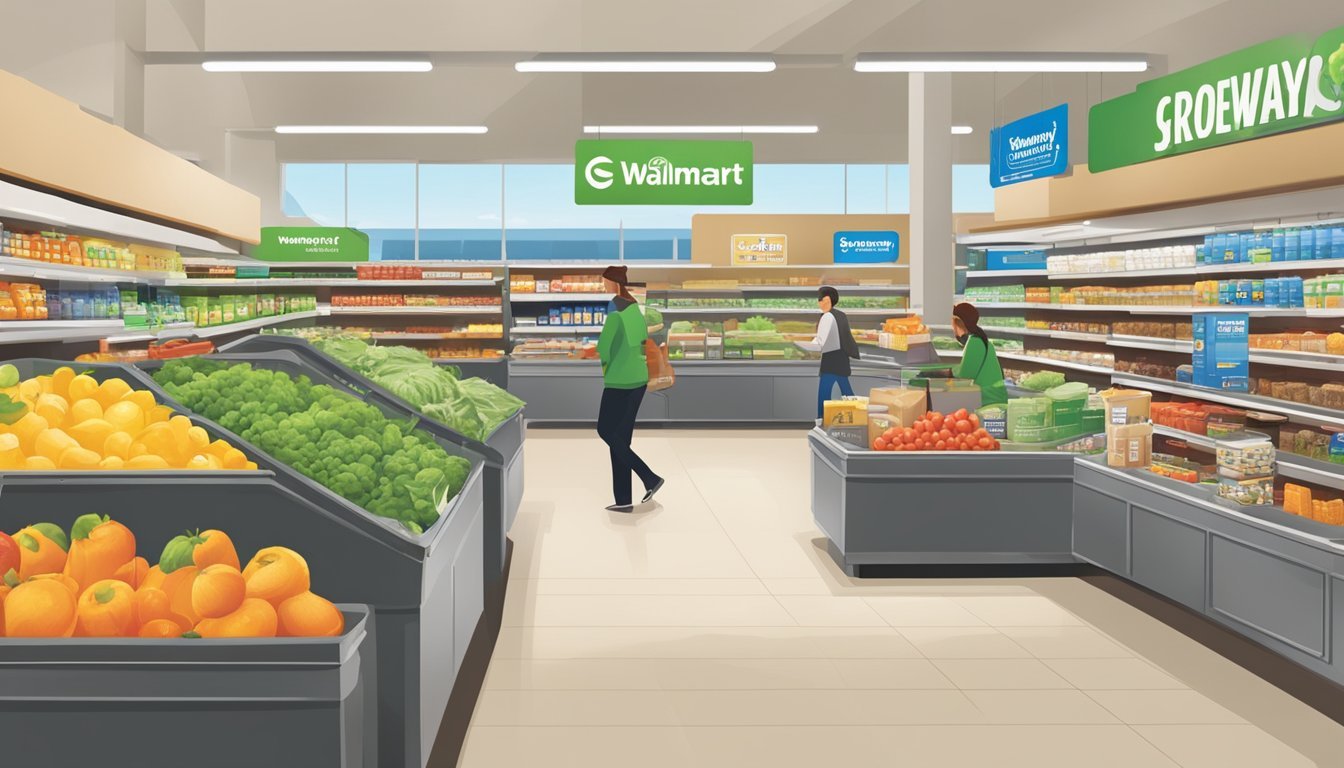Walmart vs Safeway
Comprehensive Comparison of Grocery Shopping Experiences
When it comes to grocery shopping, consumers are often torn between choosing value for money and the quality of products. Two major players in the North American retail space, Walmart and Safeway, each offer a distinct shopping experience catering to different customer needs. Walmart, with its impressive reach and store count, has built a reputation for offering everyday items at budget-friendly prices, making it an attractive option for shoppers looking to stretch their dollar further.
On the other hand, Safeway, though often perceived as pricier, focuses on providing a selection of higher-quality items, catering to those who prioritize the quality of their groceries. Thus, the decision of whether Walmart or Safeway is the better grocery store doesn’t have a one-size-fits-all answer; it heavily depends on the individual shopper's priorities—be it cost savings or product quality.
Consumers typically base their choice on a combination of factors, including price, product variety, and the overall shopping experience. While Safeway’s offerings appeal to those who are willing to pay a premium for superior items or a more specialized selection, Walmart's competitive pricing strategy and vast product assortment are designed to draw a value-conscious crowd. Consequently, which store is better is a subjective matter, reliant on what the consumer values most in their grocery shopping endeavors.
Overview of Walmart and Safeway
Walmart, founded in 1962 in Rogers, Arkansas, has grown into a global retail giant. As a hypermarket, it combines a supermarket and a discount store, making it a one-stop shop for a broad range of consumer products. Walmart operates a substantial number of stores in the USA, offering competitive prices and a vast selection of goods, encompassing groceries, electronics, clothing, and home goods.
Brands: Offers various brands including its own private labels.
Store locations: Operates in thousands of locations nationwide.
Pricing: Known for aggressive discounting and everyday low prices.
Safeway, established in 1915, is a supermarket chain with a strong presence in the Western and Central regions of the United States. Safeway focuses on a full service grocery store experience and often emphasizes quality and a premium selection of products.
Quality: Prioritizes high-quality groceries and diverse food options.
Environment: Aims to provide a pleasant shopping atmosphere.
Services: Includes specialty services such as bakeries and delis.
Both Walmart and Safeway cater to a broad customer base, but they employ different approaches to retail. Walmart is recognized for its economic pricing and extensive product range, making affordability its cornerstone. In contrast, Safeway positions itself as a traditional grocery store featuring quality and service. Each store's strategy reflects the essence of their brand, with Walmart aiming to function as a supermarket that caters to cost-conscious consumers, while Safeway targets customers looking for a specialized shopping experience with premium products.
Price Comparison
When shopping for groceries, price is often the most critical factor for consumers. This section scrutinizes the price comparison between Walmart and Safeway, focusing on everyday essentials, available discounts and coupons, and their price match policies to determine which store offers a more budget-friendly shopping experience.
Everyday Essentials
Walmart consistently offers lower prices on a wide range of everyday essentials when compared to Safeway. A shopper can expect to find the prices at Walmart to be 16% to 59% cheaper across various shopping categories. This significant price difference makes Walmart a more affordable option for consumers looking to stretch their grocery budget.
Discounts and Coupons
While Walmart's everyday prices are low, Safeway often offers a variety of discounts and coupons that can lead to substantial savings for customers. Coupons can lower Safeway's prices, making some items comparable to or even cheaper than Walmart's prices, albeit this requires coupon use and is subject to specific terms and conditions.
Price Match Policies
Both Walmart and Safeway have had price match policies in place, although the specifics may vary over time. Currently, Walmart's policy ensures that they offer some of the lowest prices in the market by matching the prices of local competitors for the same items, whereas Safeway's policy may not be as expansive. This further emphasizes Walmart's commitment to providing the cheapest option, ensuring consumers benefit from the lowest available prices.
Product Selection and Quality
When comparing Walmart and Safeway, shoppers will find notable differences in product selection and quality, which can influence their choice depending on individual preferences for variety, organic options, and store brand value.
Fresh Produce
Walmart offers a wide array of produce, including basic fruits and vegetables like potatoes and lettuce. The value is clear, with Walmart's produce generally priced lower. In contrast, Safeway tends to focus more on quality, often sourcing a selection of organic produce and featuring a more diverse range of fresh items.
Meat and Dairy
Both stores carry a range of meat and dairy products. Walmart provides affordable options, including their own store brands, which typically offer good value. Safeway often highlights the quality of their meat, including specialty cuts and organic options. Their dairy section, including milk, eggs, and sliced cheese, similarly emphasizes quality and offers a substantial variety of brands.
Store Brands vs. National Brands
Walmart is known for its extensive collection of store brands, which are competitively priced and cover everything from bread to dry goods. These brands often provide a lower-cost alternative to national brands without a significant compromise on quality. Safeway also offers their own store brands, which promise a quality that's close to or sometimes better than national brands, often at a better price point.
Organic and Specialty Options
Shoppers looking for organic and specialty food items will find that Safeway generally offers a broader selection. The premium for organic items at Safeway is justified by customers looking for higher quality options. Conversely, Walmart has been expanding its organic offerings, aiming to provide more value in this growing market segment. Both retailers have responded to consumer demand for these products, but Safeway maintains a leading position in terms of variety.
Shopping Experience
When it comes to the shopping experience, customers often weigh the ease of navigating the store, the quality of customer service, and the efficiency of the checkout process. These factors greatly influence the overall satisfaction with a grocery visit.
Store Layout and Navigation
Walmart's store layout is designed to cater to a diverse range of shopping needs, from groceries to personal care. The aisles are typically wide, with clear signage leading to various sections. Customers find Walmart stores convenient for finding both store brands and national brands. Safeway has a layout that prioritizes grocery and food items, with a flow that funnels customers through fresh produce leading into other food categories.
Walmart: Wide aisles, clear signs.
Safeway: Grocery-focused layout.
Customer Service
Customer service in Walmart can vary by location, but the chain has systems in place, such as helpers and in-aisle service kiosks, to assist shoppers. Safeway prides itself on a more personalized service approach, with staff available to help customers in their grocery selection and more personalized care in their pharmacy and personal care sections.
Walmart: In-aisle kiosks, service variability.
Safeway: Personalized service, dedicated staff.
Checkout Efficiency
Walmart has made strides in streamlining their checkout process with self-checkout stations and sufficient manned lanes to reduce waiting times. Safeway also offers self-checkout options and typically has shorter lines, but the speed can depend on the time of day and store location.
Walmart: Self-checkout, multiple lanes.
Safeway: Self-checkout, shorter lines depending on time.
Loyalty and Rewards Programs
When comparing Walmart and Safeway, their loyalty and rewards programs are a critical aspect for consumers looking to maximize their savings. Both retailers offer programs that can lead to significant discounts and exclusive offers.
Walmart operates a straightforward program with the Capital One Walmart Rewards Card. Cardholders earn rewards on purchases they make everywhere—one of the compelling benefits for loyal Walmart shoppers.
Rewards Structure:
Walmart.com: High percentage back on purchases (exact rates can vary)
In-store Walmart purchases: Lower percentage back
Rewards can be used for future purchases or statement credits
Safeway, on the other hand, provides the Just for U rewards program.
Just for U Perks:
Personalized deals: Based on individual shopping habits
Additional savings: $5 off $50 purchase or $10 off $50 purchase deals that may stack
Manufacturer's coupons: Can be used in conjunction with Just for U deals
Both programs reveal sales and best deals to their members, but they operate differently. Walmart's credit card is beneficial for those who frequent Walmart stores and websites. In contrast, Safeway's Just for U is a more traditional grocery rewards program with direct discounts applied via an app or a membership card at checkout, catering to those who prefer immediate savings.
Members of these programs gather points or receive discounts and coupons, potentially resulting in considerable yearly savings. It's up to consumers to decide which program aligns best with their shopping preferences and frequency.
Accessibility and Convenience
When comparing Walmart and Safeway, it becomes clear that both supermarkets provide distinct advantages concerning accessibility and convenience. They cater to the needs of families and everyday shoppers by providing various options for store proximity and online shopping services.
Location Proximity
Walmart boasts a larger number of stores nationwide, which often translates to greater accessibility for the average consumer. They maintain a strong presence not only in urban areas but also in suburban and rural regions, making it a convenient option for most people. In contrast, Safeway has a significant number of stores, but their presence is more regional, with a heavier concentration on the West Coast. The proximity of a store is a critical factor, as it affects the time and effort required for a shopping trip.
Supermarket Urban Stores Suburban Stores Rural Stores Walmart High High High Safeway Moderate Moderate Low
Online Shopping and Delivery
Both supermarkets have adapted to the digital age with online shopping and home delivery services to stay competitive, especially with the rise of Amazon and other online retailers. Walmart offers an extensive online platform that rivals Amazon's convenience, providing a wide array of products beyond groceries. They feature a pickup option and have partnered with delivery services to cover a broad geographic area.
Safeway, while not as vast as Walmart, also provides online grocery shopping with a reliable delivery system tailored to meet the needs of their customer base. Their focus is on delivering quality products and maintaining strong ties with their customers through their digital shopping experience.
Walmart:
Extensive online platform
Pickup and delivery options
Competes with Amazon on convenience
Safeway:
Focused online grocery service
Dedicated delivery system
Quality-driven digital shopping experience
In summary, shoppers seeking a supermarket with a wide network of physical stores and a comprehensive online presence may find Walmart to be more accessible. However, Safeway offers a noteworthy level of convenience, especially for those who prioritize quality and live near their store locations.
Brand Perception and Customer Satisfaction
In considering Walmart and Safeway, customers typically weigh the balance between the cost of products and their quality. The perception of each brand greatly influences a shopper's choice, with Walmart often recognized for its low prices and Safeway noted for its quality offerings.
Public Sentiment
Public sentiment towards Walmart and Safeway varies based on several factors. Walmart is known for its economic value, appealing to a broad demographic due to its consistently low prices. Safeway, on the other hand, garners a reputation for higher-quality goods, attracting customers who prioritize product excellence over price savings. The popularity of each brand is shaped by these attributes, influencing shoppers' trust and affecting their retail choices.
Walmart's popularity: Driven by affordability
Safeway's reputation: Centered around quality
Customer Reviews and Testimonials
Customer reviews and testimonials play an essential role in painting a picture of satisfaction for potential shoppers:
Walmart Safeway Shoppers praise the store for its extensive product range and unbeatable prices. Customers commend Safeway for its premium product selections and fresh produce. Some testimonials mention the need for improvement in Walmart’s customer service aspect. Testimonials often highlight Safeway's attentive service and cleaner store layouts.
The stores' services receive contrasting remarks, with consumers noting both the strengths and areas needing growth for each retailer. Walmart might receive critique for customer care, yet it remains a go-to for budget-conscious individuals. Safeway is frequently lauded for its customer service, further solidifying its status among those who value a superior shopping experience.
Comparative Analysis of Target Markets
In the competitive landscape of grocery chains, Walmart and Safeway cater to distinct target markets with varying demographics, shopping habits, and brand loyalty.
Demographics
Walmart's broad appeal targets a wide-ranging demographic, which includes families, individuals, and customers of various income levels. Typically, Walmart customers are drawn from a more diverse background. On the other hand, Safeway tends to attract customers who are looking for a more upscale shopping experience, potentially indicating a demographic with a higher income bracket.
Shopping Habits
Customers at Walmart often seek convenience and value, which reflects in their shopping habits. They are likely to prioritize a one-stop-shop experience, where they can fulfill all their shopping needs, from grocery to electronics. Safeway’s customers may prioritize quality and specialty products over the wide assortment, tending to shop for specific items rather than a large variety of goods.
Brand Loyalty
Walmart has built a strong loyalty among its customer base through competitive pricing and a vast network of locations. It has programs like Walmart+ that offer additional savings and convenience, fostering a loyal customer community. Safeway, with its focus on quality and customer service, also enjoys loyalty from its customers, especially those who prefer a more traditional grocery shopping experience.
Corporate Responsibility and Sustainability
When comparing Walmart and Safeway, an analysis of their approaches to corporate responsibility and sustainability reveals distinct strategies aimed at service quality and the inclusion of organic produce.
Walmart has established a multifaceted sustainability program. Commitments to environmental, social, and governance (ESG) issues are apparent through initiatives dedicated to technological innovation and customer engagement. They prioritize:
Service: Enhancing the shopping experience via omni-channel retail allows for a seamless integration of in-store and online shopping.
Quality: By focusing on safe and affordable products, Walmart strives to improve community living standards.
Organic Produce: Although not explicit in the search results, the company's long-term environmental sustainability efforts suggest a commitment to providing sustainably sourced products.
Safeway, on the other hand, approaches sustainability by concentrating on:
Quality and Service: They maintain a strong focus on high-quality products and customer service, embodying a more traditional retail outlook.
Organic Produce: Safeway offers a variety of organic and locally sourced products, catering to a market sensitive to environmental and health concerns.
Aspect Walmart Safeway Service Enhancement Omni-channel retail Traditional customer service Product Quality Safe, affordable options High-quality selections Organic Options Implied by sustainability efforts Explicit organic and local offerings
Both retailers recognize the importance of corporate responsibility and have taken steps to incorporate sustainable practices into their business models, albeit with different emphasis on direct product offerings versus broader sustainability goals.
Conclusion
Walmart prides itself on affordability, consistently offering lower prices compared to many competitors, including Safeway. They provide a wide array of options, catering to a diverse set of shoppers looking for budget-friendly choices. It's a practical destination for those aiming to stretch their dollar across a broad range of products.
In contrast, Safeway maintains a reputation for higher quality products, although at a higher price point. Shoppers who prioritize quality over cost might prefer Safeway, especially when purchasing fresh produce or specialty items.
Those interested in extensive deals may lean towards Walmart due to its everyday low pricing model, which simplifies the shopping experience by lessening the reliance on sales and promotions. On the other hand, Safeway's weekly flyers and promotions provide dedicated deal-seekers the opportunity to save on select items, offering a more traditional grocery shopping experience.
When it comes to selecting a grocery store, the shopper's individual needs take precedence. Factors such as location, product quality, brand variety, and budget constraints will influence the decision. Both Walmart and Safeway provide distinct shopping experiences tailored to different consumer preferences.
Aspect Walmart Safeway Pricing More affordable Higher cost Product Range Extensive Selective Deals Less emphasis on weekly sales Regular promotions Quality Budget-oriented Quality-focused
In conclusion, while Walmart leads in price and selection, Safeway caters to those who prioritize quality and traditional shopping experience.









